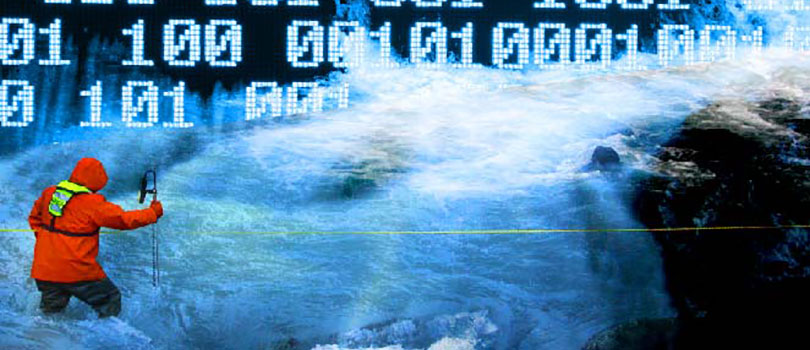
Centralizing Data to Protect the Chesapeake Bay
The University of Maryland Center for Environmental Science has been collecting data since 1938 at its founding laboratory, the Chesapeake Biological Laboratory (CBL), located where the Patuxent River meets the Chesapeake Bay. CBL is the oldest publicly supported marine laboratory on the east coast and is a leader in research on fisheries, estuarine ecology, environmental chemistry, and toxicology.
Through the years, CBL has accumulated an enormous amount of historical data at its research pier, including some of the longest records of salinity and water temperature on the United States coastline, dating back to 1938. This measurement program, initiated by CBL’s founding director Reginald Truitt, has proved invaluable in establishing baselines for changes in the estuary. Some 25,000 observations were collected with thermometers, hydrometers and wet chemistry between 1938 and 2010.
Choosing The Right Solution
In 2011, CBL evolved to a modern system involving multiparameter sondes. In 2016, the lab received a grant from the National Science Foundation to deploy new sensors to monitor the conditions of the Patuxent River. This new set of sensors significantly expanded the frequency and breadth of data collected. They moved beyond basic water temperature and salinity to also include solar radiation, current velocity, chlorophyll-a (an index of algal biomass), dissolved oxygen, and other physical, chemical and biological environmental measurements.
But this expansion of the data collection program did not come without challenges. Turning massive amounts of raw data into usable information requires modern software to centralize and validate the quality of the data using algorithms, and then provide access to all stakeholders in an easy-to-understand format.
“The sensors gave us a lot of immediate, raw information but we also wanted to use the data to estimate ecosystem conditions and report the data openly in real-time, Jeremy Testa, Associate Professor at CBL said. "To achieve this, you need continual capturing and near real-time processing of data.”
CBL chose the Aquarius platform to acquire, process, model, and publish data in real-time. The new software automatically imports and integrates sensor data, giving CBL a continuous stream of environmental intelligence without manual input or output. Some of this information is of interest to the public as they plan their recreational activities in the area, and it also provides an opportunity for scientists to discover relationships between the different data sets.
Centralizing Data to Engage Public
Community outreach is an important component of any research discipline, and it’s a central focus for the team at CBL. Giving access to real-time environmental conditions and showing their related consequences helps the public to see the relevance of changes in water conditions.
Having the data in Aquarius has made it easy to organize information and calculate parameters, such as the likelihood of sea nettles
Sea nettles are a stinging jellyfish that can be very painful to humans and, in some cases, their venom can cause an allergic reaction. CBL was able to leverage the analytical capabilities of Aquarius to predict the likelihood of sea nettles. The public can now visit the CBL web portal and see the likelihood of sea nettles before swimming or boating on the Bay.
The portal is customizable with visual dashboards displaying live data, graphs showing the conditions of the past week, links to live webcams, and local weather conditions.
The portal could also evolve with interactive mapping. This would allow visitors to zoom in to locations for a more granular look at data and color-coding features to make it easy to visualize contextual information, speeding up analysis.
The Cloud Advantage
CBL also accesses a real-time data feed from the National Oceanic and Atmospheric Administration (NOAA) for tide and weather and the US Geological Survey’s Stream Gauging.
Testa’s vision is to integrate data from other sites in the region to create a truly collaborative, real-time water measurement program. This will further CBL’s capabilities for baseline measurement and forecasting.
“Integrating data from other platforms was a motivator to move all our data to the cloud using Aquarius,” said Testa. “From an IT standpoint, having a cloud solution has taken a lot of the IT burden, like updates, security and access off of our plate, allowing us to focus on science and research.”
CBL scientists use a combination of experimental efforts, historical data analysis and coupled biogeochemical-hydrodynamic modeling studies. These efforts are greatly enriched when source data is managed and readily available through an online portal.
Unlocking Predictive Analytics with Centralized Data
The software has a unique portfolio of capabilities for error detection, data cleansing and flagging, automatic bias corrections, and rating shift management. By automating QA/QC activities, CBL can have greater confidence in sharing this information.
“We can add new measurements for water velocity, turbidity, carbon dioxide, photosynthetic light and chlorophyll levels from the different labs. Having quality-assured data at our fingertips opens the door for us to augment other research,” said Testa.
The platform gives us the tools we need to work on predictive modeling, which is increasingly important as climate change has brought changes in precipitation and associated freshwater inflow.
Historically, the Chesapeake Bay had a rich ecosystem with seagrass meadows, oyster beds and plentiful species of birds and aquatic life, but this declined in the ‘70s. Measuring water conditions over long periods of time helped to identify patterns and short-term consequences of events.
“It’s an exciting time because the platform has not only helped us to leverage our valuable history. We have what seems to be a bottomless toolkit of new capabilities allowing us to go deeper with our research and expand collaboration with all our stakeholders, knowing that our data footprint is safe and accurate” concluded Testa
Continue Learning


*Please note that this blog is a republication of a story initially published in Stormwater Solutions. To read the full article written by Senior Sales Manager Chris Heyer, click here.
Access Information Anytime, Anywhere
Experienced technology partners like Aquatic Informatics have seen it all before and can help you centralize your environmental data.
To learn more, check out our webinar on the 7 Ways to Quality Control Water Data in Real Time or get in touch directly for a demo.



